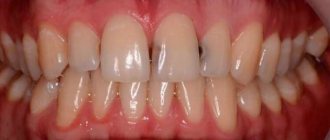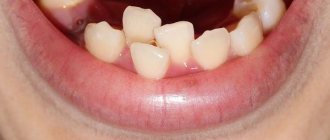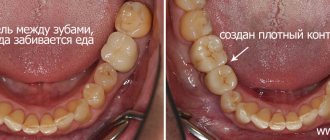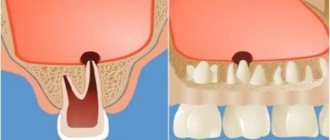Periodontium is the connective tissue adjacent to the root system of the tooth. Accordingly, periodontitis is considered an inflammation or change in the structure of tissues in this area. The periodontium consists of blood vessels, nerve connections and lymphatic formations. It performs the function of feeding the organ and distributing the load from the tooth to the bone.
Periodontal inflammation is a fairly common disease, since this diagnosis occurs as a complication of advanced dental caries. The destruction of dental tissue opens access to the internal cavity of the organ. The next stage usually becomes pulpitis - inflammation of the nerve bundle of the tooth, and if this process is not stopped, then the infection through the root canal goes deeper into the root and, as a result, leads to periodontal infection.
Of the many types of periodontitis described below, the leading position is occupied by periodontal inflammation of infectious origin. Hemolytic streptococci, entering the pulp tissue, slowly corrode it, destroying the entire tooth structure.
Symptoms and manifestations
If pulpitis is diagnosed by acute pain upon contact with cold or hot food, then the characteristic symptoms of periodontitis are painful tapping or pressing on the tooth.
This diagnosis may be indicated by:
- swelling of the cheek or gum near the tooth;
- a feeling of fullness in the tissues of the organ;
- the occurrence of a fistula with the outflow of pus into the oral cavity;
- increased pain when eating or pressing on the causative tooth;
- the feeling of an “overgrown” tooth (due to compaction of the tissues under the root, the organ begins to bulge);
- pulsation in the root area;
- increased temperature in the area of the causative tooth.
The chronic type of this disease can be asymptomatic and detected only with the help of an X-ray examination. Therefore, the insistent recommendations of the dentists of the LeaderStom clinic to undergo a dental examination by a doctor once every six months are so important for the early detection of such diseases.
Treatment methods
Treatment of inflamed interdental papillae is aimed at eliminating increased sensitivity and pain. This may include:
- rinsing the mouth with antiseptic solutions and chamomile decoction,
- applications of anti-inflammatory gels and ointments,
- taking antibacterial drugs,
- professional teeth cleaning,
- coagulation of overgrown tissues.
The treatment regimen is chosen by the doctor taking into account the diagnosis, clinical picture, and individual characteristics of the patient’s oral cavity.
Types and differential diagnosis
Like most diseases, periodontitis can occur in acute or chronic form. Sluggish periodontal inflammation is divided into three types:
Granulating
Depending on the type of infection that affects the tooth tissue, and on the specific immune response of the body, various kinds of altered tissues are formed in the periodontal cavity. With chronic periodontitis of this type, granulating tissue appears. It looks like a loose red formation near the top of the tooth root, which quickly grows and thereby destroys the bone tissue of the jaw. Of all three types of chronic inflammation, granulating periodontitis is considered the most active and pronounced. Its characteristic manifestation is the formation of fistulas, which can keep the tooth in a latent form of the disease for a long time. Connective tissue can not only affect the plate of the alveolar process (jaw), but also spread even to the skin. Therefore, advanced cases of periodontitis are much more difficult to treat and can affect large areas of tissue, including adjacent teeth. An X-ray image allows differentiation of granulating periodontitis from other types of periodontal disease. It clearly shows darkening in the area of the apex of the tooth root with circular outlines of tissue or in the form of flames. At the same time, the image does not show sharp boundaries, as in some other classifications of periodontitis. These dark spots indicate that the bone tissue has dissolved as a result of inflammation and has been replaced by connective tissue.
Fibrous
This form of the disease is quite rare and is accompanied by an asymptomatic chronic course. As a result of sluggish periodontitis, connective fibrous tissue forms around the tooth root. It is denser and is visible on an x-ray as a periodontal tooth gap, more widened than usual. The result of the appearance of fibrous tissue can be:
- suffering from acute periodontitis, which was successfully treated;
- poor-quality filling of tooth root canals;
- lack of treatment for granulating periodontal inflammation.
If the disease has entered the stage of remission (quiescence), and the patient does not complain about the causative tooth, then fibrous periodontitis cannot be treated. However, in cases of exacerbation, therapy in the form of refilling the root canals of the tooth is possible.
Granulomatous
If granulating periodontitis does not have clear outlines on an x-ray, then granulomatous periodontitis is characterized by the presence of a capsule with purulent contents. It occurs at the apex of the tooth root and gradually grows, affecting the bone tissue.
There are three degrees of development of periodontal abscess:
- Granuloma. The size of the capsule with this diagnosis reaches 0.5 cm in diameter.
- Cystogranuloma. It is diagnosed when the dense membrane reaches 1 cm.
- Cyst. More than one centimeter in diameter suggests the cystic development of periodontitis.
An increase in granuloma indicates that the inflammatory process does not find a way out and continues to dissolve the bone tissue near the tooth. In this case, a whole chain of pathological processes occurs in the human body. Sometimes particularly advanced cases showed a cyst of up to 4-5 cm in the tissue, which significantly impaired the integrity of the lower jaw, increasing the risk of its fracture.
On the other hand, the accumulation of serous fluid in the tooth area regularly causes additional intoxication to the entire body, which can be accompanied by periods of weakness, fatigue, low-grade fever and other symptoms of periodontitis.
Among all forms of chronic
Granulomatous periodontitis is considered to be the most sluggish. The fibrous tissue of the capsule serves as a protective barrier that prevents pathogenic bacteria from entering the blood. Therefore, the liquid in the capsule can remain in the tooth tissue for years without showing itself. Depending on their location, granulomas can be located either immediately under the root apex or in the tissues of the lateral cavity.
Treatment of teeth and gums
A dentist can determine why the gums between the teeth hurt based on diagnostic results - a visual examination. The treatment regimen is developed individually for each patient. This may include:
- antiseptic treatment of the oral cavity,
- professional teeth cleaning,
- treatment of periodontal pockets,
- treatment of caries and other diseases.
To prevent the situation from worsening, patients need to follow a diet for several weeks after treatment, use hygiene products and rinses recommended by the doctor, and avoid physical activity and stress.
Causes of development of chronic periodontitis
As already mentioned, one of the main causes of periodontal inflammation is untreated caries. However, the disease can develop for other reasons.
- Low quality filling materials. Some types of root fillings (especially those based on clove oil) can dissolve over time, forming empty cavities in the tooth tissue, which become a favorable breeding ground for anaerobic microbes. Other filling materials may shrink or crack, which can lead to the same result with bacteria and periodontitis. Partial filling of the root canal. Very often, when removing the pulp and cleaning the canals of the tooth, a small area remains at the apex of the root. If the canal is not completely sealed, then an infection develops in these tissues, which ultimately leads to periodontitis.
- Perforation of channels. When installing pins or cleaning channels, they sometimes break through. If a small hole in the root of a tooth is not disinfected and sealed hermetically, then inflammation will develop on the part of the periodontal tissue. This disease is characterized by the occurrence of periodontitis on the puncture side.
- Inflammation of the gums or periodontitis can also cause periodontal disease. There is a high probability of infection spreading if the patient has chronically inflamed gums with deep pockets of soft and then bone tissue. Particularly advanced cases can even lead to periodontitis of the apex of the roots.
- Tooth injuries. There is a category of people who do not consider it dangerous to crack a nut or open a beer bottle with their teeth. This bravado lasts until the tooth becomes inflamed or breaks off. Even such a “harmless” action as the habit of chewing a pen can turn into chronic periodontitis.
In addition to the obvious provocateurs of this disease, there are also secondary factors that indirectly cause or contribute to the development of incipient periodontitis in the dental tissues.
- Failure of metabolic processes in the body.
- Pathogenic microflora in the oral cavity.
- Malocclusion, which leads to injury to dental crowns.
- Chronic diseases of internal organs.
- Reduced immunity.
- Frequent infectious and viral diseases.
- Diabetes.
- Disturbances in the endocrine system.
A separate category of such factors should include poor nutrition, which leads to multiple imbalances in the body, and poor oral hygiene.
Possible diseases
Constant pain in the gums is one of the main symptoms of the following oral diseases.
- Gingivitis. Acute or chronic inflammation of the mucous membrane. Develops due to the accumulation of plaque. Soft deposits mineralize and turn into tartar, which cannot be removed with a regular brush. Pain occurs in the gums between the teeth.
- Periodontitis. Periodontal inflammation, in which the dentogingival joints are destroyed. Develops due to advanced gingivitis. The risk group includes patients with a hereditary predisposition to the disease.
- Stomatitis. An inflammatory process accompanied by the formation of blisters or ulcers. They cause burning and pain in the mouth when eating and brushing teeth. Stomatitis can be triggered by injuries, burns, as well as pathogens - herpes simplex virus, Candida fungi.
Acute periodontitis
The acute form of this disease is characterized by similar symptoms as in the chronic course of the disease, only in a more pronounced form. Sharp pain in a tooth can begin spontaneously, often at night. In this case, the slightest touch to the causative tooth leads to a “lumbago” effect. The periodontal tissues swell significantly, which causes the tooth to rise, as if to grow. This fact further injures the diseased tissue, since the enlarged tooth, when chewing, receives more pressure from the closing tooth from the other jaw.
The active phase of the disease is divided into two types:
- serous periodontitis;
- purulent periodontitis.
The first two to three days pass through a serous period, when fluid with a large number of leukocytes accumulates at the site of infection. After this time, the serous tissue becomes purulent and all the symptoms of periodontitis intensify. A so-called throbbing pain in the tooth appears, which practically does not subside. If a person has not yet consulted a dentist, then before the visit, acute pain can be eased by taking painkillers. It is simply impossible to delay going to the doctor at this stage, since the symptoms will not allow the person to eat, sleep, or live normally. The accumulation of purulent contents at the root of the tooth corrodes hard tissues, which leads to the organ’s staggering. The areas of the gums, cheeks and lips are also painful and have swelling of varying degrees. Acute purulent periodontitis is a rather dangerous disease, since in the absence of effective antibacterial treatment it can acquire various stages of complications.
- Periodontal stage. Pus accumulates in the area of the periodontal gap, causing the feeling of an overgrown tooth. This is the initial stage of dental tissue abscess, which must be stopped immediately.
- Endosseous stage. The infection, along with pus, enters the bone tissue. The process of damage to the alveolar plate begins.
- Subperiosteal stage. The amount of pus under the root of the tooth increases, and it accumulates under the periosteum. This formation is called flux. In parallel with the increase in flux, the swelling of the cheek intensifies. Acute and aching periods of pain worsen.
- Submucosal stage. It is characterized by a breakthrough of the periosteum and the release of exudate into the soft tissue. Opening the fistula relieves acute symptoms of pain in the tooth, transforming periodontitis into a chronic form. However, as soon as the outflow is disrupted, periodontitis immediately reactivates.
Periodontitis and implantation
With periodontitis, a paradoxical situation often arises: the disease leads to tooth loss, but it also prevents their restoration. It is impossible to attach a denture to mobile and weakened teeth. Classical implantation in case of periodontitis is often impossible, since the disease is accompanied by a rapid decrease in the volume of bone tissue necessary for reliable fastening of the implant.
Today, technologies have emerged that make it possible to restore missing teeth even with bone atrophy and inflammatory processes of the gums. Modern implants of a special design can also be installed for periodontitis. In certain clinical situations, the “all on 4/6” technology is actively used. The implants are placed at certain points of the jawbone that are least susceptible to changes, and the prosthesis is installed on such reliable supports. In some cases, bone tissue augmentation is also performed.
The service life of modern implants is 10 years or more. Survival rate is at least 95%. You can get more detailed information on the topic by signing up for a free consultation with Viodent specialists.
Periodontitis by location
There are two main divisions in the classification of periodontitis based on the location of the disease: apical and marginal. The first option (apical) is also apical, based near the apex of the tooth root. This type is the most common, since periodontal infection in most cases occurs through a descending channel: from caries to inflammation of the pulp, and then through the root canal the infection descends into the periodontal tissue. This process most often becomes chronic, since the protective mechanisms of the periodontium are much more powerful than those of the pulp. Therefore, the infection can enter the deep tissues of the tooth for years without causing signs of disease.
Marginal chronic periodontitis is located on the lateral walls of the tooth root and has the etiology of microtraumas.
Periodontitis, the treatment stages of which are a complex, complex process, requires immediate attention to a dental clinic. It is safe to say that such a diagnosis requires highly qualified specialists with extensive experience in solving such problems. Dentists of the LeaderStom network of clinics are rightfully considered the best in this area of dental therapy. The latest technologies, progressive techniques and extensive practice allow them to cope with the most complex, advanced cases.
What causes food getting stuck in teeth?
As a rule, those patients who become annoyed by the need to constantly remove food debris turn to a dentist for advice. They can be understood: over time, this procedure begins to take more and more time. Many people also note the appearance of bad breath. But these are only the very first signs of an unresolved and therefore progressive problem.
- By injuring the gingival tissue, food debris over time causes chronic inflammation, which is invisible to the patient due to its sluggish nature.
- Constant use of toothpicks and floss aggravates inflammation, transforming it into gingivitis and periodontitis. In the absence of treatment, in addition to the unpleasant odor, the patient will sooner or later be faced first with exposure of the tooth roots, and over time with loosening and premature loss of the teeth themselves. This is explained by the gradual resorption of the bone interdental septa adjacent to the source of inflammation.
- Poorly cleaned dental spaces become a breeding ground for pathogenic microflora that affects the contact surfaces of the teeth. Caries in these places is difficult to recognize at the initial stage and often manifests itself as severe pain already at the stage of development of pulpitis.
Treatment of interdental caries: stages
As well as the treatment of caries of other localizations, all treatment is carried out under local anesthesia.
It must be said that the treatment of caries between teeth has a certain complexity. It lies in the fact that if the chewing surface of the tooth is not yet affected by caries (Fig. 6a), then the difficulty will be in accessing the carious defect, from which it is necessary to drill out all the tissues affected by caries. To get to the caries, you have to drill out the healthy dental tissues of the chewing surface of the tooth located above the carious defect (Fig. 6b). All this leads to the fact that during the treatment process, in addition to drilling out tissues affected by caries and traditional filling of the defect, the dentist needs to do 2 difficult things:
- Restore tight contact between the teeth in the interdental space - because if the contact between the teeth is loose, then food will constantly get stuck in this interdental space, meat will get stuck, etc. All this will lead to the rapid reappearance of caries next to the filling. In order to restore the side wall of the tooth and tight interdental contact, matrices and wedges are used (Fig. 7).
It should be noted that very few dentists know how to do both efficiently. Many dentists simply turn a blind eye to this, because... Achieving these two tasks during the treatment of caries requires a very large investment of time from the dentist, as well as certain efforts and experience. - Restore the chewing surface of the tooth - with all the cusps, fissures and correct contacts with the antagonist teeth.
Treatment of interdental caries: video
Please note that to restore the side wall of the tooth, the dentist uses special metal strips (matrices) and wedges.
Treatment of caries between teeth using a specific example −
We will give an example of the treatment of a lower molar (Fig. 9-17), in which both contact interdental surfaces are affected by caries. This is not visible visually, because... the tooth is covered with a filling. Interdental caries in this case was identified using x-rays. The description of each photo opens when you click on the photo (24stoma.ru).











